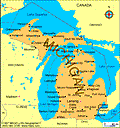 History Indian tribes were living in the Michigan region when the first European, Étienne Brulé of France, arrived in 1618. Other French explorers, including Jacques Marquette, Louis Joliet, and Sieur de la Salle, followed, and the first permanent settlement was established in 1668 at Sault Ste. Marie. France was ousted from the territory by Great Britain in 1763, following the French and Indian Wars. After the Revolutionary War, the U.S. acquired most of the region, which remained the scene of constant conflict between the British and U.S. forces and their respective Indian allies through the War of 1812. Bordering on four of the five Great Lakes, Michigan is divided into Upper and Lower peninsulas by the Straits of Mackinac, which link lakes Michigan and Huron. The two parts of the state are connected by the Mackinac Bridge, one of the world's longest suspension bridges. To the north, connecting lakes Superior and Huron, are the busy Sault Ste. Marie Canals. While Michigan ranks first among the states in production of motor vehicles and parts, it is also a leader in many other manufacturing and processing lines, including prepared cereals, machine tools, airplane parts, refrigerators, hardware, and furniture. The state produces important amounts of iron, copper, iodine, gypsum, bromine, salt, lime, gravel, and cement. Michigan's farms grow apples, cherries, beans, pears, grapes, potatoes, and sugar beets. Michigan's forests contribute significantly to the state's economy, supporting thousands of jobs in the wood-product, tourism, and recreation industries. With 10,083 inland lakes and 3,288 mi of Great Lakes shoreline, Michigan is a prime area for both commercial and sport fishing. Points of interest are the automobile plants in Dearborn, Detroit, Flint, Lansing, and Pontiac; Mackinac Island; Pictured Rocks and Sleeping Bear Dunes National Lakeshores; Greenfield Village in Dearborn; and the many summer resorts along both the inland lakes and Great Lakes. |
Michigan
Read this profile of Michigan to learn about the state's history, points of interest, and government. Also find interesting facts about each state, including the state's motto, symbols, and when it entered the union.





